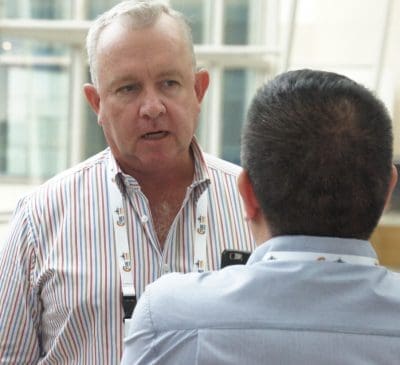Southern Queensland’s NH Foods Oakey Beef plant is one of dozens of Australian export beef processors, which for reasons not clearly understood, is unable to ship chilled beef to China.
The trade access issue was the dominant reason why Oakey Beef’s general manager Pat Gleeson decided to join this week’s TSBE Access China conference in Shanghai.
As discussed in today’s separate article, currently just 12 Australian beef export plants have access for chilled beef to the China market.
Of those, about half are not necessarily a good fit for chilled export to China, for a variety of reasons, including kills made up mostly of ineligible HGP-treated cattle.
None of Japanese-owned NH Foods three export plants – Borthwicks Mackay, Wingham Beef in NSW and Oakey Beef on Queensland’s Darling Downs – have access at this stage.
Despite offering one of the highest levels of product traceability of any large beef plant in Australia, and outstanding hygiene performance, Oakey, for some is one of the large number of plants that’s on the outer so far as China chilled exports are concerned.
To a plant like Oakey, it’s a significant issue, because a large portion of the plant’s daily kill is high quality grainfed beef sourced from NH Foods nearby Whyalla feedlot – the largest feedyard in Australia. Higher quality grainfed beef like this is best suited to chilled supply, and is certainly too good for freezing.
The lack of access to China continues, despite the fact that the factory routinely processes thousands of grainfed cattle each week for chilled markets like Japan, Korea, the US, EU and virtually every other export market in the world.
It’s one of the frustrating anomalies in dealing with the China market in terms of technical trade barriers.
Currently, there are about 62 beef export licensed plants in Australia pushing hard for market access.
“We were told at a meeting of the Export Meat Industry Advisory Council in November last year that it would be granted by January. It’s now October the following year, and still nothing,” Oakey’s Pat Gleeson said.
“That’s why we decided to get on this TSBE flight and participate in this conference, to talk with customers who might also have some influence among Chinese authorities to try to progress the situation.”
He said it appeared that being able to demonstrate ‘robust control’ of the cold chain at the Chinese end, through being able to prove the ability of particular importers and customers to handle the product appropriately, might be part of the solution in gaining a breakthrough.
“It’s about having the right connections and relationships in place, with people who have runs on the board for integrity, food safety and cold chain management.”
Mr Gleeson said the Oakey plant was 100 percent behind the Wagner family’s Wellcamp airport project outside Toowoomba, and the weekly airfreight service into North Asia.
“But unless we can get that chilled beef access to allow us to service the ‘top end of town’, then the sums just do not add up to consign frozen product by airfreight,” he said.
“We have customers in China now who are just hanging-out for our chilled product, and would take it tomorrow if it was available. It’s very frustrating.”
He said Oakey had made no secret of the fact that it wanted to diversify into retail-ready portion control business, for which airfreight would be ideal to drop frequent batches for higher-end customers into the China market each week.
“We’ve already been trialling pre-sliced primals in a Cryovac bag,” he said.
So why the need for airfreight at all, given that ageing is good for chilled beef and, the longer it spends in sea-containers the better?
“For us, it’s about consistency, continuity of supply and storage capacity,” Mr Gleeson said.
“We have higher-end customers in China who use a lot of product. This way they do not have to wait another month or two for the next consignment, and it saves on their cold storage capacity requirements – they do not have the cold chain volume to handle a single large consignment off a ship. This way, they can place an order, and have the product a week later.
“With the vision the Wagners have for the Wellcamp airport, I think we’ll see more of it,” Mr Gleeson said.
“If Australia is to be successful in export competitiveness against competitors like Brazil, we need to be able to move more from commodity-type beef to that high-end, quality product like chilled beef. That’s where our future lies.”
“None of them can touch Australia in terms of chilled shelf-life performance, but we need to stay in front of the pack.”
Oakey already kills a lot of HGP-free grainfed cattle as part of its EU program, and growing quantities of Wagyu beef did not receive HGP at all, making them ideally suited to the China market.


Unfortunately the animosity is understandable. Retribution or revenge takes many forms and “is a dish best served cold”.
I don’t imagine any of the 12 plants currently licensed to export to China have Japanese shareholders.
John Codrington is right. Chinese investment is in Australia is important, but Australians wear blinkers when it comes to making money. China thinks in centuries whereas the western world thinks in decades. Further, China is now becoming territorially aggressive, meaning that not only traditional enemies but also recent allies of traditional enemies will never become friends.
Well that’s probably the reason why! The animosity still exhibited by the Chinese towards the Japanese as result of the Japanese occupation of China in the 1930’s and ’40’s still burns deeply in China, even 70-80 years on.
Is it still owned by Japanese?
It is, Michael. Nippon Meat Packers Australia two years ago became NH Foods, still a wholly owned subsiduary of Japan’s Nippon Ham. Editor